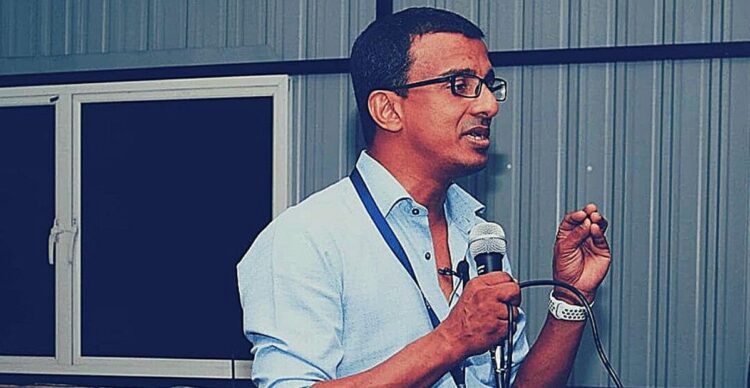“Why I Built This” is a series by HomeTree Coworking and Venture Frontier Lanka that highlights some of the best and brightest in Sri Lanka’s industries. The second episode of “Why I Built This” featured Manju Gunawardana.
Manju started off by talking a bit about himself. A senior scientist and board member at the Sri Lanka Institute of Nanotechnology, Manju is also the Group CEO of Research Innovation at LOLC. Apart from that, he has been behind a number of companies under the LOLC umbrella.
Why I Built This? To add value
Manju began his session at Episode 2 of Why I Built This by sharing that rather than simply exporting the valuable raw materials out of Sri Lanka, he brainstormed methods to make use of these materials to add value to them. Manju shared that while you would need a scientific mind to actually carry out the task, initiating an idea can be done by almost anyone with almost no experience. It just takes common sense.
In terms of innovation, Manju shared that “You don’t need in-depth knowledge to be an innovator”. You can think of something new in order to resolve a problem that you face in your day-to-day life. If you do not have the resources to solve said problem, then you can approach those who do have the resources. That is the starting point of all this.

Shifting from one field to another (literally)
From developing solutions for military use, Manju Gunawardana has shifted to a more nature-centric approach. For example, from flying UAVs, Manju now spearheads projects that use drones to agriculture problem-solving scenarios.
Drawing examples from the Meethotamulla incident, Manju shared in Episode 2 of Why I Built This, how drones were used to get a general understanding of what the actual situation was and what steps they needed to take to stabilize the problem.

Manju went on to share that the drone they used was a DJII Phantom which is a consumer-grade drone. The key was that the sensors that it was equipped with were in line with the payload of the drone. So it was just a matter of taking the existing knowledge in the field and applying it to a different scenario.
Manju’s next example was using drones to measure plant-related and agriculture-related datasets. For example, the drones would be able to measure the level of nitrogen and the greenness of plants. At the same time, the drones are equipped with spectral imaging cameras and some also have nozzles attached to them. All these technologies also help measure the field heights. These are extremely important when it comes to water management, Manju shared.

If you are to maintain a specific depth of water in a field, you need extremely level land. If it is not level, you will have variations in the water level. Once the variation has been detected, Manju shared, the next step is to act accordingly. As such, once the data from the field has been analyzed, the drones would be able to spray the areas that have a deficit in water, saving a reasonable amount of manpower and agrochemicals.
Manju emphasized that all this was carried out with consumer-grade equipment rather than more sophisticated, expensive equipment. His point was that with enough research and experience, you can innovate and create solutions to problems on a more cost-effective level.
Using Technology for a safer healthier tomorrow
Manju Gunawardana’s next case study was about consumables such as food and medicine. Using advanced technology, Manju shared how they can get an actual breakdown of the composition of processed food such as yogurt and various tablets.
With tablets and pills, it’s all about the purity of the tablet. He went on to share that the purity level in the same tablet manufactured in Europe and India, for example, would vary. This is because the latter country produces the tablet with a lesser amount of the key ingredient of the tablet so as to lower the cost.

With regards to the Easter Sunday attacks, Manju shared that by using a small FTIR (Fourier-transform infrared spectroscopy) device, he was able to identify the correct explosive used in the bombings. Rather than the commonly thought TATP (Triacetone triperoxide), it was actually Urea Nitrate which is a fertilizer-based high explosive.
Manju Gunawardana’s point was that in order to detect this, they would have usually needed a Raman Spectrometer which costs around USD 100,000. But here, they used a USD 225 FTIR device. The important thing to see here was not the device itself, but how it was used and how the trace analysis was carried out.
Graphite Content ahead
Manju Gunawardana also shared his experience in converting Graphite to Graphene. In case you didn’t know, Sri Lanka has a considerable amount of Graphite that can be mined. Graphene has a variety of uses from PCBs, to batteries to a whole heap of other use cases. It can be used as a raw material in another industry. For example, adding graphene to an Exide battery increased battery longevity by almost 200%.

Manju also shared that he requested a loan of USD 2 Million to equip SLINTEC and launch Ceylon Graphene Technologies. All this was done just within a week. Following this, SLINTEC produced the first kilogram of Graphene almost 1½ years ago. Manju was also a board member of the US Graphene Association. That relationship enabled them to send Graphene from Sri Lanka to other Graphene players. They too saw the purity of the graphite used which was of extremely high quality.
In Conclusion: Why I Built This
In conclusion, Manju Gunawardana emphasized that you don’t need structured knowledge or any type of paper qualification or training to start thinking in a different innovative manner. Always think from your heart, and not from your head, Manju added. He also shared that most of the world-class innovations come from those with almost no subject knowledge at all. If you have something simple enough for everyone to use, that is the best innovation.
If you would like to know more about the “Why I Built This” series, you can keep an eye on Venture Frontier Lanka and Hometree Coworking






GIPHY App Key not set. Please check settings